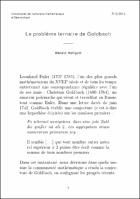| dc.contributor.author | Helfgott, Harald | |
| dc.contributor.editor | Renner, Lea | |
| dc.contributor.editor | Cederbaum, Carla | |
| dc.contributor.other | Nataf, Judith | |
| dc.date.accessioned | 2024-03-06T12:28:01Z | |
| dc.date.available | 2024-03-06T12:28:01Z | |
| dc.date.issued | 2024 | |
| dc.identifier.uri | http://publications.mfo.de/handle/mfo/4117 | |
| dc.description.abstract | Leonhard Euler (1707–1783), l’un des plus grands mathématiciens du XVIIIe siècle et de tous les temps, entretenait une correspondance régulière avec l’un de ses amis: Christian Goldbach (1690–1764), un amateur polymathe qui vivait et travaillait en Russie, tout comme Euler. Dans une lettre datée de juin 1742, Goldbach établit une conjecture (c’est-à-dire une hypothèse éclairée) sur les nombres premiers: Es scheinet wenigstens, dass eine jede Zahl, die größer ist als 2, ein aggregatum trium numerorum primorum sey. Il semble [ . . .] que tout nombre entier naturel supérieur à 2 puisse être écrit comme la somme de trois nombres premiers. | fr |
| dc.language.iso | fr | en_US |
| dc.publisher | Mathematisches Forschungsinstitut Oberwolfach | en_US |
| dc.relation.ispartofseries | Snapshots of modern mathematics from Oberwolfach;2014-03-fr | |
| dc.relation.isversionof | 10.14760/SNAP-2014-003-EN | |
| dc.rights | Attribution-NonCommercial-ShareAlike 4.0 International | * |
| dc.rights.uri | http://creativecommons.org/licenses/by-nc-sa/4.0/ | * |
| dc.title | Le problème ternaire de Goldbach | fr |
| dc.title.alternative | The ternary Goldbach problem | en |
| dc.type | Article | en_US |
| dc.identifier.doi | 10.14760/SNAP-2014-003-FR | |
| local.series.id | SNAP-2014-003-FR | en_US |
| local.subject.snapshot | Algebra and Number Theory | en_US |
| dc.identifier.urn | urn:nbn:de:101:1-2024031812233257466535 | |
| dc.identifier.ppn | 1882767551 | |


